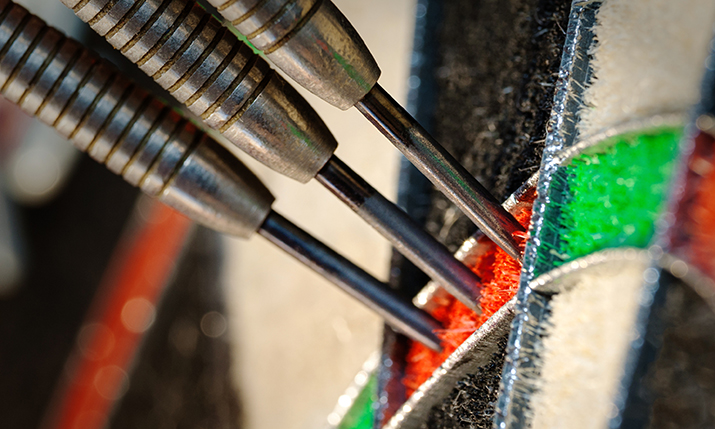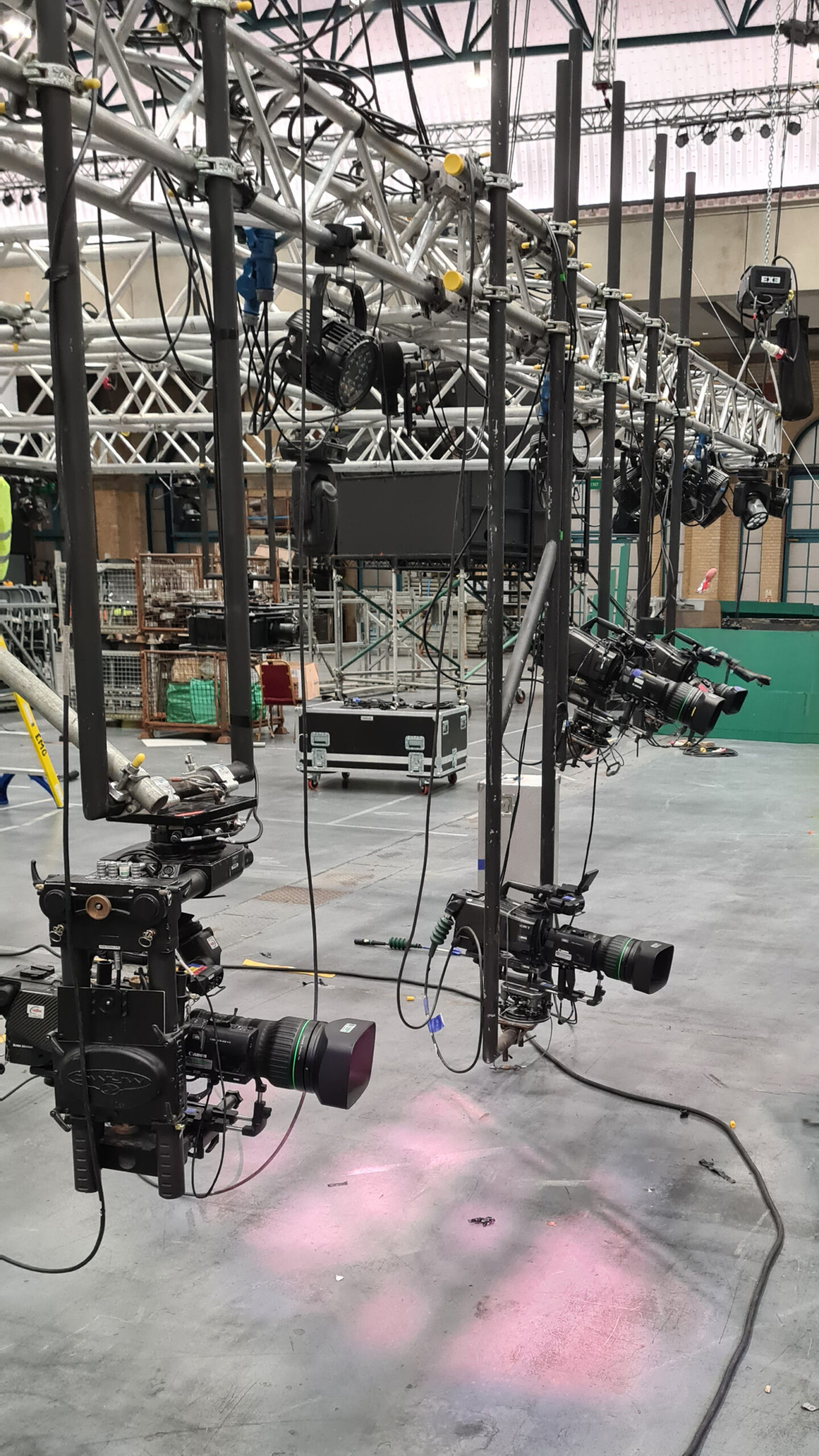EMG on board to help Sky Sports offer atmospheric coverage of the PDC World Darts Championship

With 3,000 passionate fans descending on London’s Alexandra Palace for three weeks, the live broadcast of the 2024 PDC World Darts Championship might pose a monster challenge for Sky and EMG.
However, with years of experience covering the event, and innovations like a cine-style FanCAM on hand to capture reactions, the coverage seems likely to score another bullseye.
Starting tomorrow (15 December) and concluding on 3 January 2024, the whole tournament is being shown on the dedicated Sky Sports Darts channel, with highlights on Sky Sports Main Event. EMG is on hand to facilitate coverage.
“You have to be pretty precise with your rig…there’s going to be 84,000 people weighing those seats down and a lot of beer trickling through them…you don’t want to be moving around under there for the next few weeks.”
EMG deputy head of cameras Chris Pendlebury has been the camera supervisor for Sky’s production on this event since 2017.
“It’s a massive event. We’re up to 26 operators a day for 16 days, with double sessions throughout those days,” he says.
“On the EMG side it’s a technical guarantee role: looking after the camera kit, getting it all in the right place, making sure it’s all working. On the client-facing side, I have lots of conversations with Sky, trying to figure out what works best for them, how they can get the best production with the tools we have available and with their budgets.”
Double top
The rigging workflow for such a long and labour-intensive event is both helped and complicated by the fact that EMG has also been covering the 2023 Mosconi Cup at Alexandra Palace this month. Reconfiguration for the darts started as soon as the pool tournament ended.

Cameras being rigged at Alexandra Palace
“There’s been a lot of forward planning in that regard,” says Pendlebury. “You have to be pretty precise with your rig. There’s a lot more seating built for the darts and there’s no access to some of the ducts.
“There’s going to be 84,000 people weighing those seats down [there are 3,000 fans on each of the 28 days], and a lot of beer trickling through them. So if they’ve forgotten something by now it’s going to be a lot of trouble to put it in. You don’t want to be moving around under there for the next few weeks.”
For the World Darts Championship, the production is all on site. “Darts can’t be a remote production until there is a time-traveling vision mixing desk,” suggests Pendlebury. “The cut is so fast that if you were to try and do a remote, you would be basically doing it without cue lights. The technology just does not exist yet.”
On site is NOVA 111, an SDI-based truck regularly used by Sky for cricket coverage.
“Beyond the slightly different rig for us, once it gets going, the majority of the production is all the same as when we use our IP trucks, particularly from the camera side of things. So we don’t notice a lot of difference from IP, but it’s nice to be doing it in baseband as we used to.”
New perspectives
In terms of coverage, Pendlebury says darts is the opposite to a lot of other sports.
“With darts, a lot of the main coverage is the detail and then everything else is used to bring the viewer into the event. That requires our main coverage to be really precise. We’ve got our robotic cameras down the front, supplied by a third party (MRMC covers some key camera positions via its PTA-2 robotic arm offering, including cameras 2 and 3 following the dart board as well as camera 13 in the truss for the walk ons and a shot over the shoulder throwing the dart, plus the walk-off), and we make sure they’re all programmed right and working flawlessly. We spend a lot of time on cherry pickers, lining up a series of locked off Sony 4300 cameras on the hanging truss, getting our angles right and making sure that nothing’s going to be blocked.”

EMG deputy head of cameras Chris Pendlebury
The truss cameras use Canon CJ45 4K zooms.
“We need that massive zoom to really get those details, even though we’re probably less than 10m away,” he says. “We also use the HD cut out function in the 4300s, to offer a two for one shot. The top half of the board is framed up and we use the HD cut out to really move in on the Treble 20, which is what players are often aiming for.
“What we found in the past with using those lenses is that the depth of field can be so shallow that you can have the point in focus, but the flights of the dart are out of focus, so occasionally it can look like a muddy picture. Whereas the function we use takes an HD cut out of the UHD picture, with the effect that the picture looks so much crisper, because the depth of field is so much greater. I’m not sure many other people are using that HD cut out function. But it’s really worked for us.”
Party atmosphere
There’s also the first appearance on Sky Darts of the FanCAM Cine camera system, a collaboration between ACS and EMG Connectivity. This was introduced after a handheld RF camera in super slo-mo mode worked so well last year.
“FanCAM is a DSLR [a Sony A7SIII] on a gimbal, that allows us to bring a different look and a new set of replays to the walk-ons in particular,” says Pendlebury. “It gives you that slightly more cinematic, more dramatic look. It has the ability to record in the head and play back those clips over RF, which means they are available to the EVS operators in a way that they weren’t before.
“We do all that in 4X: the player walk-ons, or after breaks and other reaction shots where they’re pumping themselves up for having taken out a massive finish. ”
“It’s allowed us to have some more access on stage, because our operators are now able to get up close to some of the players, access that was negotiated on the basis of it not being a massive camera.
“With the main coverage so often looking at the detail, it’s nice to bring in some of the other stuff going on around it. Alexandra Palace is on another level when it comes to crowd colour. It’s London’s Christmas party. The people are really into the darts, but also really into having a good time.
“With a bit of good luck and timing, you can get some really nice slow-mo reactions in the crowd shots that really add to it. It’s those moments where people are so engaged. And then suddenly you catch the change in emotions, the screams, or the heads in hands – it’s really nice to be able to play that out.”
The operators, listening to the talkback, prime their triggers and time their playbacks for such shots.
“Even without being able to see a screen, they’ve got an idea of what’s going on in the game,” says Pendlebury. “It takes a fair bit of darts experience to know when to hit that trigger and get those lovely replays out.”
Read more EMG on the artistry of sound design for the 2024 PDC World Darts Championship
In all, there are 24 cameras, consisting of the FanCAM, the RF camera, a Spidercam, eight high motion cameras, a Comcam, and 19 line cameras covering the darts and the studio.
The production is planning to use a mix of angles and frame rates to add variety to the coverage, and Pendlebury says Sky Sports director, Sean Randle, brings a great vibe to proceedings and the storytelling.
“This is an event that has gone from success to success; all these sessions in London sell out in minutes, because people are having such a good time,” he adds. “With all those locked-off cameras, they’re only pointing one way. So the story that the handhelds and the guys on the floor are able to bring is all about showing what an amazing atmosphere it is and how much people are enjoying it.”
The 2024 PDC World Darts Championship takes place at Alexandra Palace in London from 15 December 2023 to 3 January 2024

